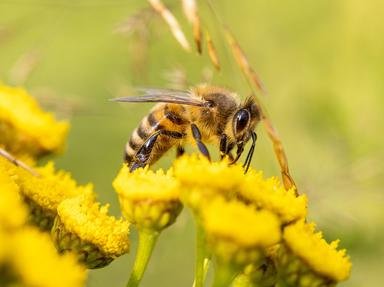Quiz Answer Key and Fun Facts
1. Which type of bee is key to the long term survival of the colony?
2. The temperature inside the hive is normally kept about 35 degrees Celsius (95 degrees Fahrenheit). This is for the benefit of the queen and her brood cells. What do the bees do when the hive gets too hot?
3. What is the main source of protein for worker bees?
4. What is it that determines whether a bee larva becomes a queen bee?
5. A bee product, propalis, could be considered the glue that holds the hive together. People have found medicinal uses for it as well as using it in car waxes, chewing gum and on stringed instruments such as violins. What is its main component?
6. The foraging range of a bee is around five kilometres, plus or minus a few. What is the key factor in determining how far a bee will forage for its food?
7. Bee-keepers will usually want to harvest as much honey as possible, which in practice means removing the winter food supply of honey from the hive. Other than honey, what is normally fed to the bees instead?
8. The queen bee typically quits the hive with a swarm of bees at some point to establish a new hive, leaving several replacement queens close to emerging from their queen cells. What is the first thing a queen will normally do on emerging from her cell?
9. Assuming you have good weather, what time of day is the best time to move a hive during the spring or summer?
10. Why is smoke used by some bee-keepers when working on a bee hive?
Source: Author
suomy
This quiz was reviewed by FunTrivia editor
Tizzabelle before going online.
Any errors found in FunTrivia content are routinely corrected through our feedback system.

